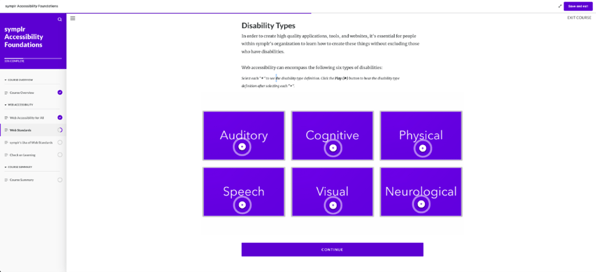Our Commitment to Web Content Accessibility at symplr

Imagine your healthcare organization has a booth at The Big Conference. A colleague who uses a wheelchair—one of 75 million people needing one daily—asks an exhibiting software company for a demo. The company representative leads your colleague to a kiosk specifically designed with their needs in mind—one that is unobstructed and can be easily accessed via forward or side reach.
Or picture this: A sales representative of a healthcare operations software company is visiting your health system. Among those excited for the demo is a visually impaired colleague—one of 285 million legally blind people worldwide. Fortunately, the sales rep’s laptop is pre-installed with the latest Job Access With Speech (JAWS), a popular computer screen reader for people who are blind or visually impaired. The rep activates the reader and your colleague easily navigates the user interface (UI), which was meticulously designed to meet Web Content Accessibility Guidelines (WCAG) Level AAA standards.
No one should be denied the opportunity to use a software solution or technology. That’s why at symplr we’re building software products that keep all users’ accessibility in mind, and we’re doing it by fostering a culture of accessibility among our own staff.
Our culture is our foundation for accessibility
Our software accessibility initiatives are design-led, but every innovation team is involved in some way. For example, symplr staff are encouraged to keep accessibility top of mind—not consider it as an afterthought. No matter our roles, we can all play a part in ensuring we create a culture that relentlessly champions every customer.
At the end of the day, we understand that we should ask ourselves, is what I designed or released accessible to everyone?
Why accessibility matters to us
Consider this: symplr's healthcare-specific software is designed and built for users across a remarkably diverse array of roles with very different demands:
- Clinicians and staff on the hospital floor in direct contact with patients (physicians, nurses, and myriad other provider types)
- Healthcare administrators and professionals in the office in payer and provider organizations (recruiters and credentialing specialists)
- Travelers who service the health system in some way (vendors and sales and service techs)
Our user experience (UX) team has a responsibility to understand all users’ needs, abilities, and challenges. It is our job to design solutions that enable everyone to do their best work—because ultimately our customers directly or indirectly serve patients in their time of need.
Plenty of room on the “sOFA”
 symplr is committed to putting a strong focus on making our products accessible to as many people as possible. This is the future of accessibility at our company. We call it the “symplr One For All Accessibility Initiative (sOFA),” and there is room for everyone on this sOFA.
symplr is committed to putting a strong focus on making our products accessible to as many people as possible. This is the future of accessibility at our company. We call it the “symplr One For All Accessibility Initiative (sOFA),” and there is room for everyone on this sOFA.
Phase 1: Awareness and education
At present we’re in phase 1 of our accessibility initiative: We are making strides to build momentum and foster a culture around accessibility. Our Senior UX Director (Jessica Hammer), Senior UX Designer (Roger Branon Rodriguez), and I have been working hard at creating awareness, education, guidance, and tools for our innovation team to use.
We recently released the first two courses of our custom-tailored accessibility curriculum, “Foundations and Principles,” with the help of Melissa Kelley and the symplr Learning Solutions team.
A screen shot of one course is pictured here:

The accessibility-focused curriculum provides our Innovation team with relevant examples and solutions. The feedback we’ve received is that the training sessions are quick, fun, and easy. And our efforts are already making an impact, as shown in these quotes from symplr staff:
- “I learned valuable information about providing enough details on the screen for our users. I knew about tab order, but I didn’t think about it in relation to error messaging/handling. —Nathan Hershkowitz, senior director of product
- "The courses were helpful and gave perspective that we don't normally think about. The guidance will help to increase adoption.” —Paul Simm, senior software engineer
- "The short-and-sweetness of the training makes it easy to refer to and so much more approachable than an hour+ long training." —Sarah Sarver, senior UX designer
What’s next for us in Phase 2
After the successful start of phase 1, we’re not resting on our laurels because we know there’s still a lot to learn about accessibility. In phase 2, we’ll strive to better understand our accessibility ratings and pinpoint opportunities for improvement. Specifically, upcoming symplr software product audits and testing using voluntary product accessibility templates (VPATs) will reveal where our products stand in terms of accessibility compliance.
To accomplish this, we’re working with an accessibility vendor to audit and provide VPATs on three of our products. This collaboration will help us understand where we are compliant, and where we need to remediate to meet compliance.
Want to learn about other strides we’ve made? Keep reading
We’re sticking to a plan:
- We created an accessibility roadmap to keep us on track. The roadmap shares the compliance we strive to achieve and the milestones to get there.
We’re creating awareness:
- Roger Branon Rodriguez got the ball rolling by hosting an introductory lunch and learn that left everyone feeling inspired. He created our vision statement and an identity for our accessibility initiative, sOFA, which is being used all over internal communications.
- We are also supplying regular updates to the larger team on what we have done and what we're doing next.
We’re educating and guiding colleagues:
- We created an accessibility committee composed of design, research, tech writing, product, engineering, and quality assurance staff. We meet monthly to make recommendations for company-wide education modules, as well as advance processes and phasing for accessibility-related initiatives.
- Thanks to our Learning Solutions team, we have outlined an accessibility training curriculum custom tailored to our team and symplr products. We released our first two courses in January and are working on more! The training will enable our team to incorporate accessibility checks into their daily work.
Keeping the end goal in mind
I began this blog by asserting that no one should be denied the opportunity to use a web-based software solution or technology. At symplr, we genuinely believe in and work hard to fulfill our company values:

Our accessibility initiative hits on multiple of these values—championing customers, leading with equality, striving for outcomes that matter to the humans who rely on our software, and more. At the end of the day, we understand that we should all be asking ourselves, is what I designed or released accessible to everyone? We’re making sure the answer to that question is a resounding “yes.”
